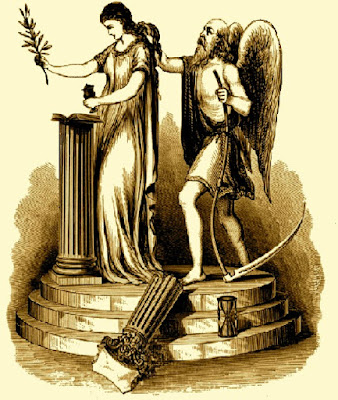Wednesday, June 24, 2020
‘Weird Fact Wednesday: A Monument in Honor of a Great Artist’
Before I begin, happy 303rd anniversary!
Depending on where you are in the Masonic world, the Master Mason Degree ritual employed by your lodge might, or might not, include a quick discourse on the final resting place of our GMHA. I think the rituals lacking this explanation intentionally seek continuity with the overall point about the immortality of the soul, meaning the disposition of the body simply does not matter. The ritual of my lodge does include this bit of legendary history; I won’t quote that here, but instead will share the version found in the unauthenticated Duncan’s Ritual—which no regular lodge uses—even though my New York ritual has a better written telling of it. From Duncan’s monitorial text:
After prayer…the body was then carried to the Temple for a more decent burial, and was interred in due form.
The body of our Grand Master was buried three times: first, in the rubbish of the Temple; secondly, on the brow of a hill west of Mount Moriah; and, thirdly and lastly, as near the Sanctum Sanctorum, or Holy of Holies, of King Solomon’s Temple, as the Jewish law would permit; and Masonic tradition informs us that there was erected to his memory a Masonic monument, consisting of “a beautiful virgin, weeping over a broken column; before her was a book open; in her right hand a sprig of acacia, in her left an urn; behind her stands Time, unfolding and counting the, ringlets of her hair.”
The beautiful virgin weeping over the broken column denotes the unfinished state of the Temple, likewise the untimely death of our Grand Master, Hiram Abiff; the book open before her, that his virtues lay on perpetual record; the sprig of acacia in her right hand, the divinity of the body; the urn in her left, that his ashes were therein safely deposited, under the “Sanctum Sanctorum, or Holy of Holies,” of King Solomon’s Temple.
Time, unfolding the ringlets of her hair, denoted that time, patience, and perseverance accomplish all things.
Monuments are in the news lately, as statues and other public memorials have been defaced, smashed, toppled, and burned during many violent rampages across the United States and beyond. It’s not about the Confederacy or slavery or Black lives mattering. It’s about cultural revolution, which we can see plainly because plenty of the monuments targeted have nothing to do with the Confederacy. Statues of Abraham Lincoln, U.S. Grant, Miguel de Cervantes, and others have been ruined. Abolitionists, like John Greenleaf Whittier and Hans Christian Heg, have had their statues attacked. On May 31, which was the 123rd anniversary of its dedication, the Shaw Memorial, which memorializes the first African-American volunteer regiment of the U.S. Army in the Civil War, was vandalized with all kinds of graffiti by those claiming to be demanding justice for African-Americans, so don’t think for a minute this destruction has even a veneer of justice on it. It is about erasing history in a manner described by George Orwell in 1984.
But this edition of Weird Fact Wednesday concerns our monument found in certain MM° rituals. Why is it there?
The monument, as described in the drama, clearly would be an anachronism, as no such thing would have existed at that historical time and in that place. Even the book, as depicted in the monument, would not have been known then. So where did this symbol come from?
We don’t find it in Preston’s Illustrations, but being a Tiler myself, I am inclined to trust the judgment of Bro. Thomas Johnson, who served as Grand Tiler of the Grand Lodge of England when he published A Brief History of Freemasonry in 1782. Therein we find a “Design for a Monument, in Honor of a Great Artist.” This shows the three Great Lights, adorned with laurels, and an urn decorated with the letter G, with the sun and moon on the sides of the monument.
Two hundred years ago, long before Freemasons could obtain official—or other—ritual ciphers or monitors, there necessarily were competing forms of Masonic works spreading across the United States. Grand lodges had to investigate and determine for themselves which systems were most authentic and useful, which I think explains why some Third Degree rituals, but not others, include this monument discussion. One of the ritual systems to emerge in the early 19th century was that promulgated by Bro. John Barney of Vermont, who is credited with innovating the icon of the marble column and the weeping virgin and Father Time, with the open book, sprig of acacia, and urn.
No doubt you are wondering where Jeremy Cross, who I think deserves third billing with William Preston and Thomas Smith Webb for creating the rituals most of us Americans have today, fits into this. It seems Cross made that column into the Broken Column, denoting how one of the principal supports of Freemasonry has fallen.
Subscribe to:
Post Comments (Atom)































































No comments:
Post a Comment